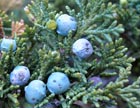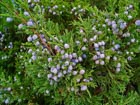Conservation Status

Juniperus sabina
Linnaeus 1753, p. 1039
Common names
Savin (Vidakovic 1991).
Taxonomic notes
The type species of Juniperus sect. Sabina, which is the largest section in the genus; it falls within a clade where its sister species include the J. chinensis complex, the J. virginiana complex, J. davurica (sometimes treated as a variety of J. sabina), and J. semiglobosa. There are two varieties:
- Juniperus sabina var. balkanensis R.P.Adams & Tashev (Adams et al. 2016). Type: Greece, Mount Tsena, 41.142°N, 22.242°E, elevation 1630 m, R. P. Adams 14730, 2015.08.31 (Holotype BAYLU). This is an unusual variety because it is generally a good J. sabina but the chloroplast genome is nearly identical to that of J. thurifera. Evidently, var. balkanensis arose when an ancestor of J. sabina captured the chloroplast of an ancestor of J. thurifera during a hybridization event at a time when the species' distributions overlapped (Adams et al. 2016).
- Juniperus sabina var. sabina. Type locality unknown. Many synonyms, see POWO.
There are two named hybrids. Juniperus × herragudensis J.M.Aparicio & Uribe-Ech. is the hybrid of J. phoenicea and J. sabina (Rojo and Uribe-Echebarría 2008). Juniperus × pfitzeriana (Späth) P.A.Schmidt, a tetraploid, is the hybrid of J. chinensis and J. sabina (Schmidt 1983).
Description
Dioecious evergreen shrubs to 4 m tall, but usually more or less prostrate. Bark cinnamon brown, exfoliating in thin plates. Twigs densely arranged, ascending, slender, 0.8-1 mm thick. Leaves both needle-like and scale-like. Needle-like leaves almost exclusively on juvenile plants, decussate or in whorls of 3, closely appressed, 3-7 mm long, adaxially concave with with a sharp-pointed apex. Scale-like leaves almost exclusively on adult plants, decussate, rhombic or rhombic-ovate, 1-2.5 mm long with a prominent central abaxial gland. Pollen cones not described; pollen shed in late winter or spring. Seed cones terminal on curved twigs, light brownish green, maturing purplish-blue or black at the end of the second summer after flowering, often glaucous, irregularly globose, 5-8 × 5-9 mm, containing (1-)2 seeds. Seeds ovoid, slightly flattened, 4-5 mm long, ridged and bearing resin pits, apex blunt or slightly pointed (Adams 2014). See García Esteban et al. (2004) for a detailed characterization of the wood anatomy.
The morphological differences between the varieties are so minor that var. balkanensis might reasonably be called cryptic. Compared to var. sabina, it has slightly finer and darker green foliage, the scale leaf tips are more obtuse and the glands are not apparent, the whip leaf glands are elongate (three-quarters of the leaf length) and flat or sunken, and the seed cones are mostly reniform (Adams et al. 2016).
It can also be challenging to distinguish J. sabina from J. davurica; for details, see the key for J. davurica. However, by far the most widespread variety of J. davurica, the type variety, is readily distinguishable because it bears both needle-like and scale-like foliage on the same branches, on mature plants. This does not happen with J. sabina.
Distribution and Ecology
Albania?, Algeria, Andorra?, Armenia, Austria, Azerbaijan, Belarus, Bosnia and Herzegovina, Bulgaria, China, Croatia, Czechia, France, Georgia, Germany, Greece, Hungary?, Iran, Italy, Kazakhstan, Kyrgyzstan, Liechtenstein?, Luxembourg, Moldova, Mongolia, Montenegro, Netherlands, North Macedonia, Poland, Romania, Russia, Serbia?, Slovakia, Slovenia?, Spain, Switzerland, Tajikstan?, Turkey, and Ukraine (question marks denote areas within the expected distribution where no collections have been reported). Being widely cultivated, it may also be naturalized in other countries; collections have been reported in most of northern Europe, to as far north as Finland. Habitats are varied, including forests and thickets, vegetated sand dunes, and rocky mountain slopes (Adams 2014). Adams (2014) reports occurrences at elevations of 1000-3300 m, but a review of GBIF data indicates 10% of records are at elevations of 0-800 m and 10% are at elevations of 1980-3000 m, with 80% between 800 and 1980 m and a median elevation of 1450 m. Var. balkanensis has only been reported from Greece and Bulgaria (Adams et al. 2016). Hardy to Zone 3 (cold hardiness limit between -39.9°C and -34.4°C) (Bannister and Neuner 2001).
Remarkable Specimens
No data as of 2025.01.04.
Ethnobotany
The seed cones and foliage are poisonous (Vidakovic 1991). In traditional medicine, its foliage was used as an abortifascient. For this reason, cultivation of this species was long prohibited in France (L'Herbier Virtuel 1998). This is, however, a popular ornamental (Vidakovic 1991), as is the horticultural hybrid with J. sabina, called J. × pfitzeriana (Farjon 2010).
Observations
No data as of 2025.01.04.
Remarks
The epithet is from sabine (or variants), an old French name for junipers.
The foliage and the seeds contain sabinol (a terpenic alcohol) and gallic acid, which is transformed into pyrogallol. Consumption of the foliage causes a severe irritation of all mucous membranes. The sabinol attacks the nervous system, causing convulsions. The pyrogallol blocks the intestinal circuit completely. Death occurs quickly (L'Herbier Virtuel 1998).
Citations
Adams, Robert P. 2014. Junipers of the World: The Genus Juniperus. Fourth edition. Trafford Publishing. Brief versions of the descriptions are available online at Adam's website, www.juniperus.org.
Adams, Robert P., Andrea E. Schwarzbach, and Alexander N. Tashev. 2016. Chloroplast capture in Juniperus sabina var. balkanensis R. P. Adams and A. N. Tashev, from the Balkan peninsula: A new variety with a history of hybridization with J. thurifera. Phytologia 98(2):100–108.
L'Herbier Virtuel. 1998. http://www.lenet.fr/vegetal/herbier/herbier2.html, accessed 1998.10.05, now defunct.
Rojo, J., and P. Uribe-Echebarría. 2008. Juniperus herragudensis, otro nuevo
híbrido de la provincia de Castellón. Mainhardt 60:83–85.
Schmidt, P. A. 1983. Folia Dendrol. 10:292.
See also
Elwes and Henry 1906-1913 at the Biodiversity Heritage Library. This series of volumes, privately printed, provides some of the most engaging descriptions of conifers ever published. Although they only treat species cultivated in the U.K. and Ireland, and the taxonomy is a bit dated, still these accounts are thorough, treating such topics as species description, range, varieties, exceptionally old or tall specimens, remarkable trees, and cultivation. Despite being over a century old, they are generally accurate, and are illustrated with some remarkable photographs and lithographs.
Farjon (2005) provides a detailed account, with illustrations.




